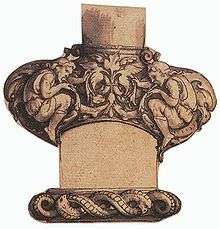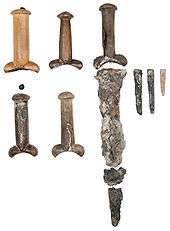Bollock dagger


A bollock dagger or ballock knife is a type of dagger with a distinctively shaped shaft, with two oval swellings at the guard resembling male testes ("bollocks"). The guard is often in one piece with the wooden grip, and reinforced on top with a shaped metal washer. The dagger was popular in Scandinavia, Flanders, Wales, Scotland and England between the 13th and 18th centuries, in particular the Tudor period. Within Britain the bollock dagger was commonly carried, including by Border Reivers, as a backup for the lance and the sword. A large number of such weapons were found aboard the wreck of the Mary Rose. The bollock dagger is the predecessor to the Scottish dirk.
In the Victorian period weapon historians introduced the term kidney dagger, due to the two lobes at the guard, which could also be seen as kidney-shaped, in order to avoid any sexual connotation. (Blair 1962).
The hilt was often constructed of box root (dudgeon) in the 16th and 17th centuries, and the dagger was sometimes called a dudgeon dagger or dudgeonhafted dagger in this period.
References
- Blair, C. (1962). European and American Arms c. 1100—1800. B. T. Batsford, London.
External links
- Spotlight: The Ballock Dagger (myArmoury.com article)
- Mary Rose Trust